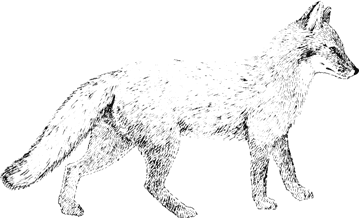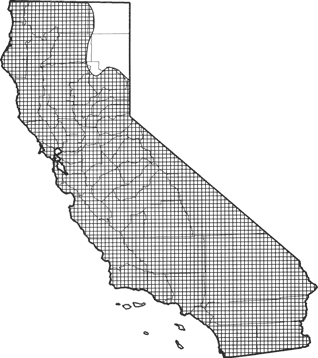
Common Gray Fox
Distribution, Abundance, and Seasonality
Uncommon to common permanent resident of low to middle elevations throughout most of the state. Frequents most shrublands, valley foothill riparian, montane riparian, and brush stages of many deciduous and conifer forest and woodland habitats. Also found in meadows and cropland areas.

Range Map
Specific Habitat Requirements
Feeding: Omnivorous. Rabbits, mice, gophers, woodrats, and squirrels are the principal foods (Trapp and Hallberg 1975). Also eats large amounts of fruits, nuts, grains, grasshoppers and crickets, beetles, moths and butterflies, carrion, and small amounts of herbage. Stalks and pounces on rodents and rabbits, or may pursue for short distances. Readily climbs into crooked trees, or those with branches 3 m (10 ft), or less, from the ground (Ingles 1965).
Cover: Brush, natural cavities, and occasionally human-made structures, provide cover.
Reproduction: Dens in natural cavities, in rocky areas, snags, logs, brush, slash and debris piles, abandoned burrows, and under buildings. Nest material usually dry grass, leaves, or shredded bark.
Water: Requires a permanent water source near den; probably drinks daily.
Pattern: Suitable habitat consists of shrublands, brushy and open-canopied forests, interspersed with riparian areas, providing water.
Species Life History
Activity Patterns: Active all year. Primarily crepuscular and nocturnal, occasionally active in daytime.
Seasonal Movements / Migration: Non-migratory.
Home Range: In Wisconsin, home ranges varied from 0.13 to 3.1 km? (0.05 to 1.2 mi?). In Florida, home ranges averaged 7.7 km? (8 mi?), and in Utah, home ranges averaged 1.0 km? (0.4 mi?) (Trapp and Hallberg 1975). Near Davis, California, Fuller (1978) found that 4 females had an average home range of 1.2 km? (0.5 mi?).
Territory: Family groups (parents with juveniles) usually are separated spatially, indicating territoriality (Trapp and Hallberg 1975).
Reproduction: Mates February through March. In California, most births occur in April (Grinnell et al. 1937), following a gestation of approximately 63 days. Average litter size is 4 pups; range 2-7 (Fritzell and Haroldson 1982). One litter/yr. Males and females are sexually mature at 1 yr.
Niche: Adult gray foxes have few predators. Large hawks, golden eagles, great horned owls, domestic dogs, and bobcats may prey on pups. May carry tularemia and rabies (Jennings et al. 1960, Jackson 1961). Population levels may be affected by rabies.
Sources & References
California Department of Fish and Game, 1999.
California's Wildlife, Sacramento, CA.
Written by: G. Ahlborn, reviewed by: M. White, edited by: M. White
Fritzell, E. K., and K. J. Haroldson. 1982. Urocyon cinereoargenteus. Mammal. Species. No. 189. 8pp. Fuller, T. K. 1978. Variable home-range of female gray foxes. J. Mammal. 446-449. Grinnell, J., J. S. Dixon, and J. M. Linsdale. 1937. Fur-bearing mammals of California. 2 Vols. Univ. California Press, Berkeley. 777pp. Ingles, L. G. 1965. Mammals of the Pacific states. Stanford Univ. Press, Stanford, CA. 506pp. Jackson, H. H. T. 1961. Mammals of Wisconsin. Univ. Wisconsin Press, Madison. 504pp. Jennings, W. L., N. J. Schneider, A. L. Lewis, and J. E. Scatterday. 1960. Fox rabies in Florida. J. Wildl. Manage. 24:171-179. Lord, R. D., Jr. 1961. A population study of the gray fox. Amer. Midl. Nat. 66:87-109. Seymour, G. 1968. Furbearers of California. Calif. Dep. Fish and Game, Sacramento. 55pp. Trapp, G. R. 1978. Comparative behavioral ecology of the ringtail and gray fox in southwestern Utah. Carnivore 1:3-32. Trapp, G. R., and D. L. Hallberg. 1975. Ecology of the gray fox (Urocyon cinereoargenteus): a review. Pages 164-178 in M. W. Fox, ed. The wild canids. Van Nostrand, Reinhold Co., New York. 508pp.
California Animal Facts | California's Wildlife